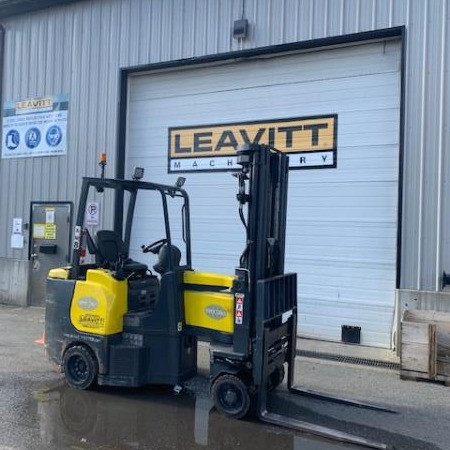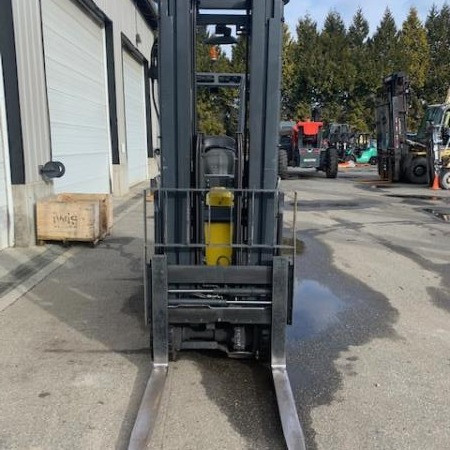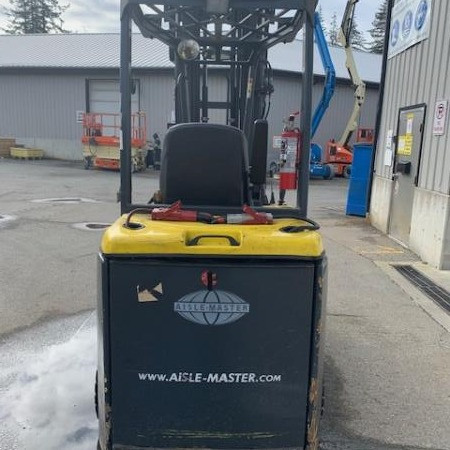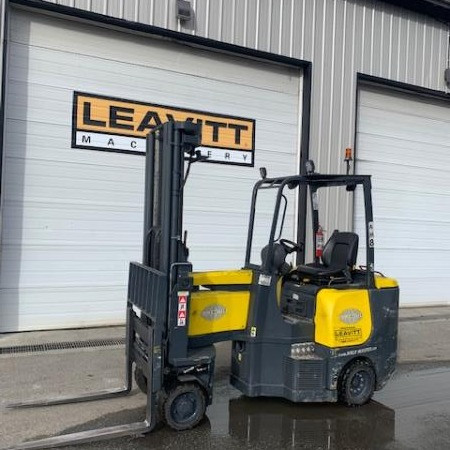Very Narrow Aisle Forklift Seattle
Used Very Narrow Aisle Forklift Seattle - Warehousing solutions often focus on layout and space saving solutions in order to cut down on costly square footage and decrease travel time required to transport goods throughout the warehouse and loading dock areas. Extremely narrow aisles offer more storage space since there is less space needed for aisle access. Configuring the warehouse is known as warehouse optimization.
Warehouse Optimization
Several benefits can be enjoyed for adding very narrow aisle warehouse optimization such as more storage space for the facility.
Using narrow forklift trucks instead of traditional forklifts can enable the warehouse width of the aisles can be lessened to half. Certain models of very narrow aisle forklifts can increase the square foot storage capabilities by delivering greater stacking heights. This means that costs are decreased because less warehouse space is necessary for the same amount of stock than if a standard aisle configuration were used. Square footage is costly in urban areas and any way to reduce warehousing costs can save a company money. When planned carefully and properly, it is possible to increase warehouse storage area by up to 80 percent by implementing a very narrow aisle width configuration. This warehouse design creates more rack faces and increased product access. Reduced travel time for storing items and gathering products are some of the key benefits to this warehouse layout as more products are found in an accessible location.
It is common for warehouses to use a very narrow or narrow aisle layout. Narrow aisles are usually those that use less than 11 feet of aisle width. These widths reduce even further to roughly 6.5 feet for very narrow aisles. Both of these aisle widths provide significantly increased storage opportunities. Using a forklift for order picking and stocking can be difficult in these aisle widths, especially when turning. A variety of very narrow forklifts have been designed to easily maneuver in narrow aisles.
Before choosing a forklift for a particular job, it is vital to know the dimensions of the aisle. Having the right aisle dimensions will save money and time instead of purchasing the wrong forklift that won’t be able to conquer the applications. Finally, it is critical that any utilities, posts or columns are taken into account before settling on a specific narrow aisle forklift design as these may affect access to aisles by some forklifts or prevent warehouse optimization.
Very Narrow Aisle Forklift Trucks
As these units are mostly powered by electricity, rechargeable batteries are popular for very narrow aisle forklifts. These very narrow aisle trucks are more commonly available as stand-up riders, which helps increase productivity and operator comfort. There are different very narrow aisle forklift designs such as order pickers, reach trucks, wing-mast or turret and end-control riders.
Reach Forklift Trucks
Developed as a kind of rider stacker forklift, the reach forklift trucks can be configured for narrow aisle locations. It got its name by its function of reaching its forks forward to get to a load. The two kinds of reach trucks the moving carriage and the moving mast. The moving carriage works by raising and lowering the carriage, along with the operator. The moving mast works by raising and lowering the forks along the mast, while the operator stays at ground level. The moving mast reach truck is generally considered the safer of the two types of reach trucks. These machines rely on a kind of jointed framework known as a pantograph system that enables the operator to place a load or reach the load without moving the machine.
Order Pickers
Order pickers have been created to pick items from difficult, high racking systems. Order pickers are specific for lighter stock items that can be lifted by hand. They lift the operator up to reach the goods by identifying and choosing certain items to create an order.
End-Control Riders
End-control riders are machines that pick loads up at floor level and move the items horizontally as opposed to lowering or lifting over numerous heights.
Turret or Swing-Mast Forklift
Swing-mast or turret very narrow aisle forklifts feature an articulating swivel mast that pivots. The mast swivels allowing pallets to be placed on either the left or right of the forklift.
Guided Very Narrow Aisle Trucks
Many very narrow aisle forklift trucks are able to be guided down aisles by wire or rail.
Because the forklift is guided, thereby reducing the possibility of the forklift bumping racks while moving down the aisle, the aisles can be extremely narrow. In rail-guided models, sets of rails are placed into the floor on each side of the aisle. They run the length of the aisle and also curve around the aisles’ edge. Specific wheel guides are on the forklift. These slide into the rails to stop the forklift from moving out of the rail guards.
Wire-guidance forklift systems install wires on the floor instead of rails and the wires run down the middle of the aisle. The wire-guides function similarly to the rail systems except the forklift has a wire-guide system to prevent the machine from traveling where it is not supposed to.
Work Site Considerations
To use a narrow aisle configuration, there are some key considerations that need to be made. The floor and the rack construction needs to be evaluated to avoid any issues since the very narrow aisle units have extremely high racking systems. Four specific areas need to be perfectly prepared before a racking system can be implemented including a level floor, plumb racks, any floor cracks need to be repaired and the floor’s load capacity must be accurate. These locations need to be maintained and monitored continuously.
Level Floor
Due to the racking system height, any minor floor slope can gravely impact how plumb the racks are, particularly over time if loads are placed and removed repeatedly on the racks. The height of the racking system means that any minute floor slope can have a negative impact on how straight the racks are, especially over time when loads are continually removed and placed on the racks. Without a level floor foundation, the rack stability could be compromised.
Crack Repair
When there are floor cracks found, they need to be assessed and immediately fixed for safety concerns. Cracks may affect the floor’s level and, when they are approximately 3/8 inches wide, will need to be properly filled with a material at least as hard as the surrounding floor.
Floor Load Capacity
Minimum flooring requirements must be met before considering a narrow aisle installation. Minimum flooring requirements include concrete measuring three thousand psi and rebar distributed evenly three to four inches below the surface. Extra reinforcements might be needed depending on the load requirements and the configuration.
Plumb Racks
Of great importance is the proper installation of the racking system. If installed improperly, there is a great chance of rack failure. Every rack needs to be plumb to ensure a safe system and work environment. Rack shims can help the rack stay plumb to one inch at the height of thirty feet.
Racking failure can happen if the aforementioned measures are not taken or implemented correctly. Racking failure can kill or injure employees, damage equipment and result in horrible damage. Because of these reason, these measures are the most important part of implementing a narrow aisle configuration for warehousing optimization.
Very Narrow Aisle Forklift PDF
Stock Number: 208758 GL
Make: AISLEMASTER
Model: 44SE
Year: 2015
| Stock Number |
208758 GL |
| Make |
AISLEMASTER |
| Model |
44SE |
| Year |
2015 |
| Category |
Very Narrow Aisle Forklift |
Stock Number: 209213 GL
Make: AISLEMASTER
Model: 44SE
Year: 2015
| Stock Number |
209213 GL |
| Make |
AISLEMASTER |
| Model |
44SE |
| Year |
2015 |
| Category |
Very Narrow Aisle Forklift |
Stock Number: 207213 GL
Make: AISLEMASTER
Model: 44E
Year: 2013
| Stock Number |
207213 GL |
| Make |
AISLEMASTER |
| Model |
44E |
| Year |
2013 |
| Category |
Very Narrow Aisle Forklift |













